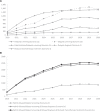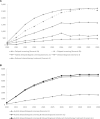Impact of the COVID-19 Pandemic on Breast Cancer Mortality in the US: Estimates From Collaborative Simulation Modeling
- PMID: 34258611
- PMCID: PMC8344930
- DOI: 10.1093/jnci/djab097
Impact of the COVID-19 Pandemic on Breast Cancer Mortality in the US: Estimates From Collaborative Simulation Modeling
Abstract
Background: The coronavirus disease 2019 (COVID-19) pandemic has disrupted breast cancer control through short-term declines in screening and delays in diagnosis and treatments. We projected the impact of COVID-19 on future breast cancer mortality between 2020 and 2030.
Methods: Three established Cancer Intervention and Surveillance Modeling Network breast cancer models modeled reductions in mammography screening use, delays in symptomatic cancer diagnosis, and reduced use of chemotherapy for women with early-stage disease for the first 6 months of the pandemic with return to prepandemic patterns after that time. Sensitivity analyses were performed to determine the effect of key model parameters, including the duration of the pandemic impact.
Results: By 2030, the models project 950 (model range = 860-1297) cumulative excess breast cancer deaths related to reduced screening, 1314 (model range = 266-1325) associated with delayed diagnosis of symptomatic cases, and 151 (model range = 146-207) associated with reduced chemotherapy use in women with hormone positive, early-stage cancer. Jointly, 2487 (model range = 1713-2575) excess breast cancer deaths were estimated, representing a 0.52% (model range = 0.36%-0.56%) cumulative increase over breast cancer deaths expected by 2030 in the absence of the pandemic's disruptions. Sensitivity analyses indicated that the breast cancer mortality impact would be approximately double if the modeled pandemic effects on screening, symptomatic diagnosis, and chemotherapy extended for 12 months.
Conclusions: Initial pandemic-related disruptions in breast cancer care will have a small long-term cumulative impact on breast cancer mortality. Continued efforts to ensure prompt return to screening and minimize delays in evaluation of symptomatic women can largely mitigate the effects of the initial pandemic-associated disruptions.
© The Author(s) 2021. Published by Oxford University Press. All rights reserved. For permissions, please email: journals.permissions@oup.com.
Figures


References
-
- American College of Radiology. States with elective medical procedures guidance in effect. https://www.acr.org/-/media/ACR/Files/COVID19/May-18_States-With-Electiv.... Accessed November 20, 2020.
-
- EPIC Health Research Network. Delayed cancer screenings--a second look. https://ehrn.org/articles/delayed-cancer-screenings-a-second-look. Accessed December 29, 2020.

